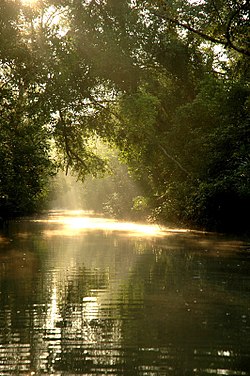 Sunderbans, the biggest mangrove forest in the world |
| Part of a series on |
| Wildlife of Bangladesh |
|---|
 |
Wood is the main fuel for cooking and other domestic requirements. [1] It is not surprising that population pressure has had an adverse effect on the indigenous forests. [1] By 1980 only about 16 percent of the land was forested, and forests had all but disappeared from the densely populated and intensively cultivated deltaic plain. [1] Aid organizations in the mid-1980s began looking into the possibility of stimulating small-scale forestry to restore a resource for which there was no affordable substitute. [1] Bangladesh Forest Research Institute (BFRI) is the government organization under Ministry of Environment, Forest and Climate Change for research in this sector which was established in 1955 at Sholoshahar, Chittagong city. [2]
The largest areas of forest are in the Chittagong Hill Tracts and the Sundarbans. [1] The evergreen and deciduous forests of the Chittagong Hills cover more than 4,600 square kilometres (1,800 sq mi) and are the source of teak for heavy construction and boat building, as well as other forest products. [1] Domesticated elephants are still used to haul logs. [1] The Sundarbans, a tidal mangrove forest covering nearly 6,000 square kilometres (2,300 sq mi) along the Bay of Bengal, is the source of timber used for a variety of purposes, including pulp for the domestic paper industry, poles for electric power distribution, and leaves for thatching for dwellings. [1] The total percentage of forests are 10.98%.[ citation needed ]
